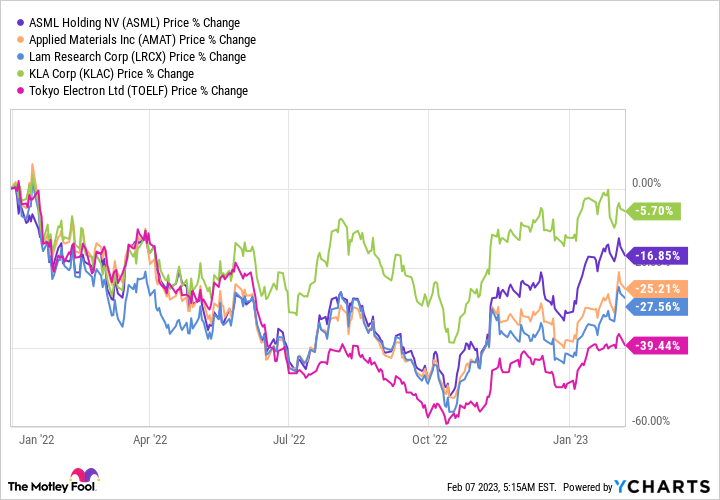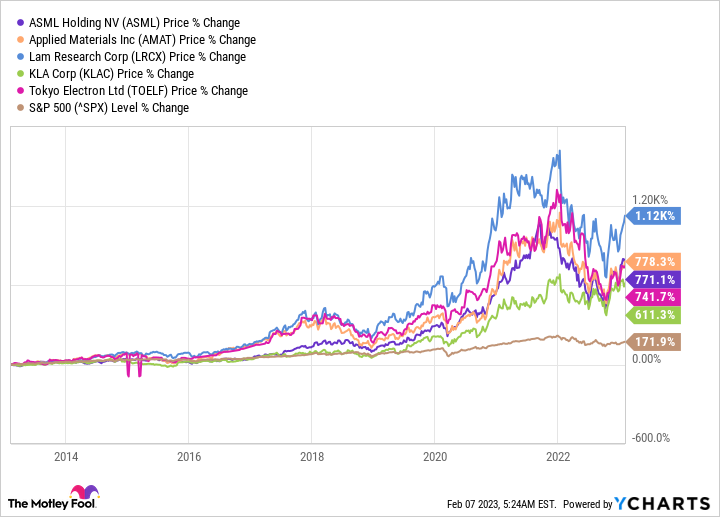A Key Semiconductor Industry Metric Just Turned Ugly: Time to Sell Chip Stocks? – The Motley Fool
Founded in 1993, The Motley Fool is a financial services company dedicated to making the world smarter, happier, and richer. The Motley Fool reaches millions of people every month through our premium investing solutions, free guidance and market analysis on Fool.com, top-rated podcasts, and non-profit The Motley Fool Foundation.
Founded in 1993, The Motley Fool is a financial services company dedicated to making the world smarter, happier, and richer. The Motley Fool reaches millions of people every month through our premium investing solutions, free guidance and market analysis on Fool.com, top-rated podcasts, and non-profit The Motley Fool Foundation.
You’re reading a free article with opinions that may differ from The Motley Fool’s Premium Investing Services. Become a Motley Fool member today to get instant access to our top analyst recommendations, in-depth research, investing resources, and more. Learn More
Some financial data looks especially ugly right now, but remember: The market cares about the future far more than the present.
Semiconductors are the building blocks for much of the technology that so many sectors of the economy rely on, and semiconductor importance is only growing as industries across the whole economy incorporate an increasing number of chips into their operations to make them more efficient. Because of this, investors everywhere should pay some attention to the semiconductor industry’s outlook.
One important metric governing the outlook for chips just turned negative. According to semiconductor industry advocate Semi.org, global spending on semiconductor equipment (machines and related equipment used in manufacturing electronics) is poised for a steep decline in 2023. Does this mean it’s time to sell top stocks like ASML (ASML 1.56%), Applied Materials (AMAT 3.71%), and Lam Research (LRCX 3.29%)?
Back in December, Semi.org predicted total semiconductor equipment sales would increase to $108.5 billion in 2022, up from $102.5 billion in 2021 and mark the third straight year of growth. With the chip shortage in full effect through most of 2022, most chip fabs (the facilities that make chips) were fully booked and trying to increase capacity to meet their customer demands.
The organization also said that total equipment is expected to finally contract in 2023 to just $91 billion — an expected 15% drop, though still far above pre-pandemic spending. Of this total, wafer fab equipment (or WFE, the machinery that makes the silicon wafers that eventually get cut up into chips) makes up the bulk of sales. Wafer equipment could fall as much as 17% in 2023 to about $79 billion in global sales, down from an estimated $95 billion in 2022.
Data source: Semi.org. Chart by author.
Though 2023 is looking ugly for fab equipment, Semi.org’s report is hardly a surprise. As late as autumn 2022, some chip companies started to report weakness in consumer electronic sales after a more than two-year spending spree brought on by work-from-home device upgrades. Then, as supply chains started to open up again and the chip shortage began to ease, there was suddenly a glut of consumer electronics inventory. Device manufacturers slammed on the brakes as a result.
To compensate, chip fabs also tapped the brakes by paring back expense plans for 2023, including on fab equipment. The market saw this coming, resulting in a cascade effect reminiscent of a freeway pileup that hit chip fab equipment stocks especially hard. The top five players in the WFE subindustry — ASML, Applied Materials, Lam Research, Tokyo Electron (TOEL.Y 2.75%), and KLA (KLAC 3.36%) — took it on the chin in 2022. 
Data by YCharts.
In hindsight, the time to sell WFE stocks was late 2021.
Interestingly, not long before Semi.org’s report on 2023 WFE sales, chip equipment stocks started rallying in a grandiose fashion. As of this writing, many have even held on to those gains during their rally that started a few months ago. What gives?
One possible answer is that WFE stocks got far too cheap last autumn. But there’s more at play here. Though the outlook is dismal for the immediate future, Semi.org said in a related report that the semiconductor industry will be investing some $500 billion in new factory construction from 2021 to 2023. Indeed, the world has an insatiable appetite for chips, and global semiconductor sales are expected to go from an estimated $570 billion in 2022 to over $1 trillion every year by 2030.
Eventually, the current cyclical downturn will end, and new manufacturing facilities will be needed to meet global demand. Thus, the estimate is that by the end of 2023, WFE spending begins to rally and could reapproach record annual spending again in 2024. It’s already February 2023, so the market doesn’t seem to think eyeing a second-half 2023 sales heat-up is too soon.
Plus, while the overall WFE outlook is poor for the coming couple of quarters, not all companies will notch a slump. ASML expects a huge rebound in its revenue this year as advanced chips for AI and cloud computing outperform the market. And KLA also recently reported an expectation for sales of its inspection tools to remain stable.
Then there’s the simple fact that many of these stocks are still quite cheap — especially considering that they will remain highly profitable even during this downturn, and are using excess cash to repurchase stock. Despite the inherent cyclicality of their businesses, stocks like ASML, Applied Materials, and the other top names have been long-term market beaters.
Data by YCharts.
In all, though key semiconductor industry metrics have turned negative for 2023, things are looking up for the second half of the year. Now looks like a fantastic time to buy chip fab equipment stocks if you plan to own these high-quality businesses for the next decade.
Nicholas Rossolillo and his clients have positions in ASML and Applied Materials. The Motley Fool has positions in and recommends ASML, Applied Materials, and Lam Research. The Motley Fool has a disclosure policy.
Invest better with The Motley Fool. Get stock recommendations, portfolio guidance, and more from The Motley Fool’s premium services.
Making the world smarter, happier, and richer.
© 1995 – 2024 The Motley Fool. All rights reserved.
Market data powered by Xignite and Polygon.io.
